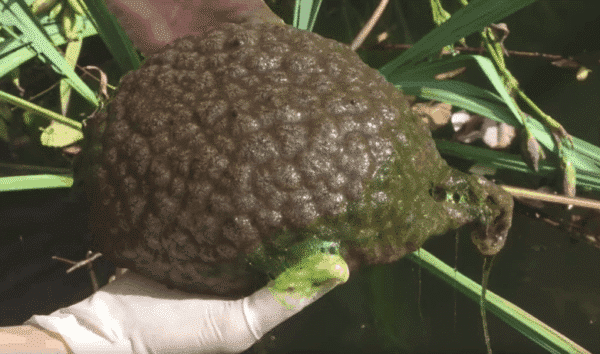
 Scientists accompanied by a team of volunteer bio-enthusiasts have just discovered a strange new species lurking in the depleted waters of Stanley Park’s Lost Lagoon. Owing to their appearance, some are calling it a “Dragon Booger”.
Scientists accompanied by a team of volunteer bio-enthusiasts have just discovered a strange new species lurking in the depleted waters of Stanley Park’s Lost Lagoon. Owing to their appearance, some are calling it a “Dragon Booger”.
The fresh water bryozoan (Pectinatella magnifica) is actually a minuscule creature only about half a millimetre long, sporting a crown of tentacles covered with fine hairs. But lumped and living all together in a colony of thousands, the so-called moss animals take on a unique and uniquely slimy, snot-like appearance, varyingly described as brain-like blobs of goo,“magnificent” dragon boogers or even a giant peeled lychee fruit.
Or, as Kathleen Stormont of the Stanley Park Ecology Society puts it to the Vancouver Courier, “It’s kind of like three-day- old Jello — a bit firm but gelatinous. They’re a colony of tiny organisms that like to hang out together,” says Stormont. “They have a very ancient lineage that hasn’t changed for hundreds or thousands of years.”
The bryozoan were picked from the Lost Lagoon as part of a “bio-blitz” survey of flora and fauna in Stanley Park, led by the Stanley Park Ecology Society. The third of its kind, involving over a thousand visitors, the blitz saw citizen scientists identify hundreds of organisms in the park.
“Our scientific surveys were led by our committed team of scientists and experts leading 21 walks and surveys,” says Celina Starnes, Public Education and Outreach Manager with the society. “Community members of all ages had the opportunity to meet and learn about creatures’ homes, while scientists collected data about which species reside in the park.”
The Dragon booger loves warm water
Some experts say that the bryozoan, which can only survive in waters warmer than 15 degrees Celsius, may be spreading to new areas as a result of climate change, although Ian Walker, biology professor at UBC, isn’t fully convinced, saying that there’s a lack of research on the creature’s habitat to say for sure.
“It’s something that could have been easily overlooked in the past,” says Walker, to NationalGeographic, pointing out that bryozoan have been found in the Okanagan Valley, as well. “I think we’re near the northern limit of them,” says Walker. “With warming climate, they might migrate somewhere farther north. I can only really speculate how they might have spread,” he says.
The Dragon booger first appeared in Washington State a few years ago
The US Fish and Wildlife Service reports having received increasing concerns over large summertime blooms of Magnificent bryozoan, attesting that each gelatinous blob can grow to as much as seven feet (2.1 metres) in diameter, turning a “dark vibrant purple with shiny white spots.” The report states that users of Vancouver Lake in Vancouver, Washington, noticed them in the lake for the first time in the summer of 2011.
Starnes says that scientists have pinpointed this freshwater species of bryozoan’s origin as along the Mississippi. “They’ve been dispersing westward ever since,” she says, “so every once in a while they’ll show up in a place like this, in a freshwater ecosystem.”
The Stanley Park bio-blitz is one contribution to a national “celebration of biodiversity” across Canada to help commemorate the country’s 150th anniversary.
Leave a Reply
You must be logged in to post a comment.



 Share
Share Tweet
Tweet Share
Share




Comment